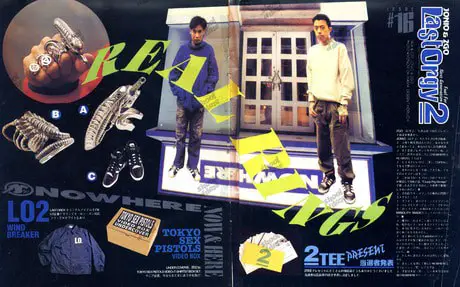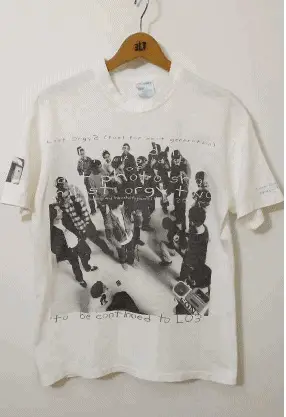Examing the early roots of Nigo, A Bathing Ape, Last Orgy and beyond
A Bathing Ape, or BAPE, is one of the world’s most popular brands, specializing in streetwear and lifestyle clothing. BAPE’s founder Nigo is almost as famous as his brand, having collaborated with everyone from musicians such as Pharrell Williams and Kanye West, to brands like Pepsi, Stüssy, and Adidas. Japanoscope has translated a 1997 interview with Nigo here.
BAPE has inspired collectors around the world to purchase anything associated with the brand, with some of the collectors becoming popular on Instagram, and even getting interviewed about the extent of their collections.
What Does Bape stand for?
Bape is short for “A Bathing Ape In Lukewarm Water”. The initial concept came from Japanese illustrator and designer Skate Thing who got the idea after seeing an illustration of a monkey in a hot spring (itself an image famously associated with Japan).
The other inspiration behind the name comes from the Planet of the Apes film, which features a society that has fallen down due to excess and hedonism. Nigo was a big fan of pop culture, including Planet of the Apes. In BAPE immagery, the ape can be seen as a symbol of human kind in its most “primitive form”. So the image of the monkey-man, sitting in Luke warm water, as if he had been lazing around in a luxurious bath so long that the water was starting to go cold, was an ironic dig at the consumer culture of the Bubble-era Japanese youth generation that Nigo was born into.
Before starting the BAPE clothing line in 1993, Nigo was known as Tomoaki Nagao and he looked up to the Japanese musician and fashion icon Hiroshi Fujiwara, especially Fujiwara’s Last Orgy series. So what was Last Orgy?
Last Orgy 1
In 1986 Japanese musicians Hiroshi Fujiwara and Takagi Kan released their first music as Tiny Panx on the album 建設的(Construction), which was released as a joint album with Seiko Ito. The Tiny Panx name, which changed from Tiny Panx Organization, T.P.O., Tinnie Punx, Tiny Panx, Tiny Punx, and TPO depending on the release, was inspired by Fujiwara’s nickname given to him while he had spent time in London during the 1980’s.
Inspired by his time in London and New York during the 80’s, Fujiwara had returned to Japan influenced by the exploding hip hop scene, and Tiny Panx became one of the earliest Japanese hip hop groups, who would support the Beastie Boys on their Japan tour in 1987.
In 1988 Tiny Panx released the song Last Orgy on the influential Japanese record label Major Force. This was Major Force’s debut release, and the label would go on to release music by Toshio Nakanishi aka Tycoon Tosh from Plastics and Melon, DJ Red Alert of The Wild Bunch, and the Japanese hip hop group Scha Dara Parr.
Last Orgy contains a mixture of English and Japanese lyrics, with the Japanese delivered in an English accent at times, making the lyrics almost hard to decipher.
Last Orgy English Translation
Peter and Fumiko from Japanoscope listened through to the track and did their best to transcribe the words, and the below is their best approximation. XXXs represent bits they couldn’t take a good guess at. If anyone has a better idea of what this says, please let us know!
Approx Japanese level
Text Type
How to make / Loving is student
Now I’m telling you / Geisha Boys
You moving / まずはそこから
Feel the beat yo / ラップに決ら
Little punx / Listen while I say
All the bullshit / Try to walk this way
Got to keep xxxx / You don’t stop
その気になるまでやらなきゃど
Rhymingしなけりゃ始まらない
575resumeはget no fight / DJの作り出すリズムをget XXX / すかさずマイクでXXX
Deepになりたきゃ今Rock hard
Major Corporation Boyそうしたら
Xxx / 俺はMCカン
酔い出しゃ止まらぬBoogie Wonderland
Last Orgy / Just tonight
マイクのチエック123 / Check it on the needle
それどうり / Ready now
ひろしはいつでもTry to get busy
Tiny Punks / The place to be
黙っていれずに
Gonna Rock Baby Ready for rock yeah
用意は出来てる
Last orgy / Last orgy just tonight
Last orgy / Last orgy just tonight
Kan’s rhymeは やくざ Machine gun おまけに中身はAin’t no冗談 目の前そのまま現実Hard core Watch out / いつでも体をCheck you? Xxx よりの近未来 チェルノブイリに Green Mile Straight to hell / ごめんだ wake up Punkもserious / Never see the future? Xxx / Keep the party / Never negative xxx on the mic / Like this Beep Jump up / Movin’ and groovin’ and chillin’ and illin’ and xxx Xxx / Kan China Say yeahIn 1987 Fujiwara and Kan were invited to start a column in the Japanese magazine Takarajima, and they called the column Last Orgy, with the column making its debut in Takarajima’s July 1987 issue. Through the column they wrote about, promoted and recommended music, clothing, and film, focusing on what would become known as Street Culture. The monthly column became influential and spun off into a TV series airing on FM-TV in Japan, which featured the same content but this time in video.
The July 1987 issue looked like this:
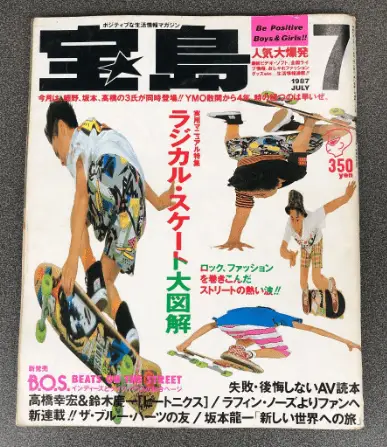
Here’s Kan and Hiroshi scratching it up on the Last Orgy TV show.
One of their fans was a young Tomoaki Nagao who would record each episode of Last Orgy and re-watch them with his friends on repeat. Last Orgy influenced Nagao’s decision to move to Tokyo and enroll at the fashion institute 文化服装学院 (Bunka Fashion College) where he met the aspiring designer Jun “Jonio” Takahashi.
Tomoaki Nagao soon earned himself the nickname Fujiwara Hiroshi Nigo, Fujiwara Hiroshi Number Two, due to Nagao’s likeness to Fujiwara. Nagao embraced the nickname and he soon after met Fujiwara who hired Nigo as his personal assistant, with the two becoming friends. In 1993 when Nigo and Jonio decided to open their own store it was with the support of Fujiwara, and their Nowhere store became an important part of Japanese street culture history.
Last Orgy 2
While working as an assistant to Fujiwara, Nigo also began a part-time job at the Japanese culture magazine Popeye where he contributed a new column titled Last Orgy 2. This new column was written by Nigo and Jonio and served as a continuation of the Last Orgy by Fujiwara and Kan which had ended around 1990.
In 1991 Nigo and Jonio collaborated on the Last Orgy 2 t-shirts, which continued to be released into 1994. These featured assorted designs, from photography, to text, and were released through their Nowhere store, with the back of one t-shirt detailing the Last Orgy history and announcing that as of June 1994 the Last Orgy 2 column was finished but would be relaunching soon as Last Orgy 3.
For Christmas 1994 a Last Orgy 2 Stadium Jacket was released, and this design was later re-released in 2009 alongside several t-shirts, as part of a promotion for a new Nowhere store opening in Hong Kong.
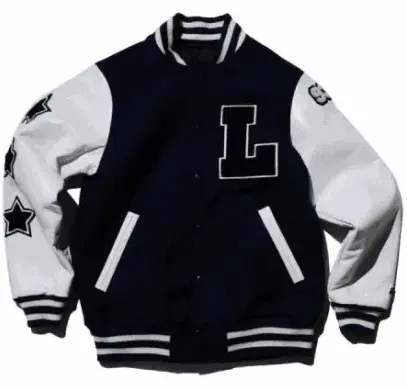
Last Orgy 3
In September 1994, Nigo and Jonio collaborated with Fujiwara on a new column titled Last Orgy III, which was now in the culture magazine Asayan. By now Nigo had his BAPE line, Jonio was running his Undercover brand, Fujiwara had his Good Enough clothing line, and the Last Orgy III column tended to focus on these brands, serving as a promotional advertisement for Nigo, Jonio, and Fujiwara’s brands, as well as promoting their Nowhere store.
You can see some Last Orgy articles in English translation here.
In 1995 there were still new Last Orgy 2 t-shirts produced, as well as a new Last Orgy song.
In the 1990’s James Lavelle had started the Mo’ Wax record label in England and collaborated with the Japanese label Major Force, eventually re-releasing most of their catalogue to a wider audience. Through his friendship with Major Force, Lavelle soon met Nigo and the pair became friends, with Lavelle soon inviting Nigo to record in the Mo’ Wax studios in London. This collaboration would eventuate in Nigo’s debut album Ape Sounds, a mix of hip hop and rock similar to Lavelle’s own UNKLE project. Nigo also collaborated with Lavelle on the Planet of The Apes inspired song Ape Shall Never Kill Ape, which featured members of Major Force, UNKLE, Nigo, and UK turntablists The Scratch Perverts all on one song.
During this period Lavelle also released a song called Last Orgy 3, which featured Takagi Kan rapping much like on the original Tiny Panx song which had released almost ten years previously in 1988. Last Orgy 3 first appeared in 1997 on a mix CD by Nigo and James Lavelle titled A Bathing Ape Vs Mo’Wax, and was later released on CD and Vinyl with several remixes in 1998.
Last Orgy 4…and beyond.
The final Last Orgy so far, Last Orgy Four was a t-shirt collection released around 2000, and is the only Last Orgy to have been released without an associated magazine column, tv series, or song sharing its title. Around this time Nigo and Jonio were contributing a column titled 4lom to Smart magazine, which was similar to Last Orgy and had begun in 1996 and continued in to the 2000’s, while Nigo also contributed his General’s Seminar columns to Relax magazine for several years in the early 2000’s.
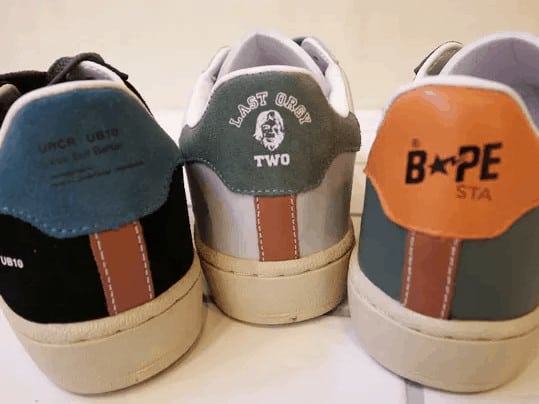
IAlongside the 2009 re-release of the Last Orgy jacket was a Last Orgy shoe which released in 2010. The shoes were a collaboration with Nigo’s BAPE company and featured their Bapesta shoe design. Since then there has been little news of further Last Orgy lines, but the brands close ties to BAPE may be one of the reasons for the draught, as in 2013 Nigo left BAPE and is now working with the Japanese brand Uniqlo.
There are even Bape masks made for those that want to maintain style during pandemics.
But what of the original Last Orgy creators, Hiroshi Fujiwara and Takagi Kan? Both of the original Tiny Panx have continued to work in their respective fields, with Fujiwara regarded as an important part of the Japanese fashion world, with his career recounted in two large English language books from publisher Rizzoli.
Meanwhile Kan continues to release music with Major Force, and in 2020 he has been putting on live performances via his Instagram page while the world has been locked down during the Corona Virus pandemic.
Further Reading:
Ametora: How Japan Saved American Style by Marx, W. David
Hiroshi Fujiwara: Fragment by Sarah Lerfel and Ino Hidefum
Why is Bape so expensive?
Even though Bape makes street ware, the idea of “luxury” is part of its core. From the start, its branding was based around an ironic take on “A Bathing Ape in a Luke Warm Hot Spring”, meaning a primitive person soaking up the luxury. So its no suprise that Bape pricing reflects this focus on the hedonistic urge.
This fits in with the larger trend within hip hop and street cultures to fetichize wealth in the form of gold chains, diamonds and brands.
In a way, it is odd that this question is asked about Bape more than any other brand at the high end of the market such as, say, Apple. The cost of anything is rarely based on just the cost of what an item cost to produce.
Contributor
James Gaunt is an artist, writer and musician based in Tokyo.

